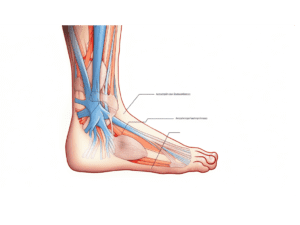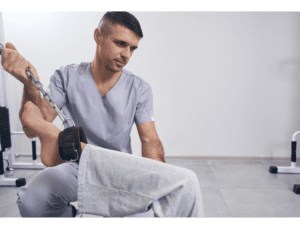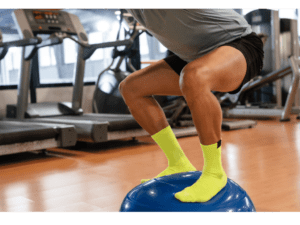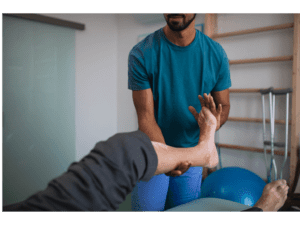Ankle Pump Exercise
The ankle pump exercise is a widely recognized and recommended technique for enhancing lower extremity circulation. Its efficacy lies in the repetitive flexion and extension movements of the ankle, which stimulate blood flow and prevent venous stasis.
By exaggerating these actions through controlled repetitions, individuals can reap the benefits of improved muscle strength, enhanced joint mobility, and expedited post-surgical recovery.
This article aims to provide a comprehensive overview, including its scientific underpinnings, step-by-step instructions, variations for tailored engagement, as well as potential pitfalls to avoid.
Key Takeaways
- Ankle pump exercises improve lower extremity circulation and prevent venous stasis.
- These exercises increase blood flow velocity in the common femoral artery and promote better circulation throughout the lower limbs.
- It enhance joint mobility, flexibility, and overall leg strength.
- Regular and consistent performance of these exercises, with proper form and gradually increasing intensity, maximize their benefits and prevent muscle strain or injury.
Understanding the Ankle Pump Exercise
It is a therapeutic technique commonly used in rehabilitation to improve ankle range of motion and circulation.
This exercise involves dorsiflexion and plantarflexion of the ankle joint, which activates the muscle pump mechanism. The muscle pump refers to the contraction and relaxation of muscles surrounding blood vessels, facilitating blood flow through them.
By performing this exercise, blood flow velocity increases as the movements compress and decompress blood vessels, aiding in venous return from the lower extremities. This can be particularly beneficial for individuals at risk of developing deep vein thrombosis (DVT), a condition characterized by the formation of blood clots in deep veins.
Regular implementation of this exercise can help mitigate such risks while promoting overall circulation improvement in patients undergoing rehabilitation programs.
The Science Behind Ankle Pump Exercises
Scientific research reveals the physiological effects of performing a specific movement to enhance mobility in the lower extremities.
These exercises involve rhythmic flexion and extension of the ankle joint, which has been found to have several beneficial effects on blood flow and preventing blood clots.
Research has shown that performing these exercises can increase blood flow velocity in the common femoral artery, promoting better circulation throughout the lower limbs.
Additionally, varying ankle positions and exercise intervals during ankle pumps can further enhance their effectiveness.
Ankle Pumps: A Closer Look at the Benefits
Ankle pumps, a common therapeutic exercise for the lower extremities, offer several benefits for individuals recovering from various conditions or injuries.
Firstly, ankle pumps help to improve circulation by stimulating blood flow and preventing blood pooling in the lower limbs.
Secondly, these exercises enhance joint mobility and flexibility by promoting ankle dorsiflexion and plantarflexion movements.
Lastly, ankle pumps can aid in reducing swelling and edema by facilitating lymphatic drainage through repetitive muscle contractions.
Overall, incorporating ankle pumps into rehabilitation programs can contribute to improved vascular health, enhanced range of motion, and reduced swelling in the lower extremities.
Benefits of Ankle Pumps
Evaluating the benefits of ankle pumps can provide insight into their potential usefulness for improving lower extremity circulation. It involve repetitive flexion and extension movements of the ankle joint, which can promote blood flow in the lower limbs.
The benefits of ankle pumps include:
- Enhanced blood circulation: Ankle pumps stimulate the calf muscles, facilitating venous return and reducing pooling of blood in the lower extremities.
- Prevention of blood clots: Regular exercises help prevent deep vein thrombosis by promoting blood flow and preventing stasis within the veins.
- Improved muscle strength and flexibility: It engage various muscles surrounding the ankle joint, leading to increased strength, stability, and range of motion.
Step-by-Step Guide to Performing Ankle Pump Exercises
To perform it correctly, one should follow a step-by-step guide.
Begin by sitting on a chair with your feet flat on the floor.
Slowly move your feet up and down, as if you are pushing your toes towards the ground and then pulling them back towards yourself.
This motion mimics pumping water with your ankles.
Ensure that you maintain a slow and controlled movement throughout the exercise.
Aim to perform ankle pumps several times a day for optimal results.
It is important to note that these exercises are beneficial for improving blood circulation, reducing swelling, preventing blood clots, and increasing range of motion in the ankles.
Variations of Ankle Pump Exercises
This paragraph aims to introduce a discussion on the variations of toe drawing exercises and their associated benefits.
Toe drawing exercises can be performed in various ways, including flexion, extension, and abduction movements of the toes. These variations allow for targeted strengthening and stretching of different muscles in the foot and ankle complex.
Toe Drawing Variations
One variation of toe drawing in ankle pump exercises involves flexing the toes towards the sole of the foot. This variation targets the muscles in the feet and can help improve circulation in the lower extremities. This specific toe-drawing variation, are often recommended for individuals who may have limited mobility or are recovering from surgery or injury.
By performing ankle pumps several times a day, individuals can experience calf muscle contractions that help increase blood flow to the legs and feet. This increased circulation can aid in reducing swelling and preventing blood clots.
Incorporating different variations into a daily routine can promote overall leg strength and flexibility while also enhancing vascular health.
- It involve flexing and extending the ankles.
- Toe drawing variations specifically target muscles in the feet.
- Performing ankle pumps several times a day improves circulation by contracting calf muscles.
Benefits of Variations
A variety of toe drawing variations can be beneficial in promoting muscle strength and flexibility in the feet while also improving circulation in the lower extremities. These variations offer additional benefits, enhancing its efficacy. By incorporating different toe positions and movements, individuals can target specific muscles and increase their range of motion.
The benefits of these variations include improved foot stability, increased blood flow to the feet, enhanced proprioception, and strengthened arches. Regularly performing ankle pumps several times a day with various toe drawing variations can help prevent foot problems such as plantar fasciitis and Achilles tendonitis. Additionally, these exercises aid in maintaining joint health by reducing stiffness and increasing flexibility in the ankles.
Overall, incorporating toe drawing variations into ankle pump exercises provides a well-rounded approach for strengthening the feet and improving lower extremity function.
The Role of Ankle Pump Exercises in Deep Vein Thrombosis Prevention
IT plays a significant role in the prevention of deep vein thrombosis (DVT). DVT is a condition characterized by the formation of blood clots in the deep veins, typically in the legs. It involve flexing and extending the ankle joint, which helps stimulate blood flow and prevent blood pooling.
It’s role in DVT prevention can be understood through these key points:
- Increased Blood Circulation: Ankle pumps improve circulation by facilitating venous return and preventing stasis.
- Muscle Activation: It activate the calf muscles, which act as a natural pump to assist with blood flow.
- Reduced Risk of Blood Clot Formation: Regular ankle pumps help prevent blood clot formation by keeping the blood flowing smoothly through the veins.
Ankle Pumps and Post-Surgery Recovery
Facilitating blood circulation and muscle activation, the incorporation of this exercise into post-surgery recovery routines can potentially enhance overall vascular health and reduce the risk of complications.
Ankle pumps involve moving the ankle joint up and down, which helps to increase blood flow and prevent blood clots from forming.
Post-surgery recovery is a critical period during which patients are at an increased risk of developing deep vein thrombosis (DVT) due to immobility. By performing this regularly, patients can stimulate venous return, preventing stasis and reducing the likelihood of DVT occurrence.
Additionally, ankle pumps promote muscle activation in the lower extremities, assisting in maintaining or regaining strength after surgical procedures.
Therefore, integrating this into post-surgery recovery protocols is a simple yet effective way to optimize vascular health and minimize potential complications.
Ankle Pump Exercises: Tips and Tricks for Success
Maximizing the benefits is crucial for optimal recovery and rehabilitation.
This discussion will explore key strategies to enhance the effectiveness of ankle pumps, focusing on technique, frequency, and progression.
Maximizing Ankle Pump Benefits
To optimize the benefits, it is important to consider strategies that enhance its effectiveness. Here are three key strategies to maximize ankle pump benefits:
- Consistency: Performing this regularly and consistently is crucial for maximizing their benefits. It is recommended to perform ankle pumps several times a day, aiming for at least 10 repetitions per session.
- Range of motion: Ensure that you are achieving the full range of motion during ankle pumps. This means fully extending your foot upward and downward with each repetition. Maintaining proper form will help target the muscles effectively and promote optimal joint mobility.
- Gradual progression: Start with gentle exercises and gradually increase intensity as your strength improves. Pushing yourself too hard too soon can lead to muscle strain or injury, so it is essential to progress at a pace that suits your individual abilities.
Complementary Exercises to Boost the Effectiveness of Ankle Pumps
Supplementing ankle pumps with additional exercises can enhance their effectiveness in improving ankle strength and range of motion. Ankle pump exercises, which involve flexion and extension movements of the ankle joint, are commonly used in rehabilitation programs for various lower limb conditions.
While ankle pumps alone can provide benefits, incorporating complementary exercises can further boost their effectiveness. Complementary exercises such as calf raises, toe curls, and balance training not only target different muscle groups but also challenge the stability and coordination of the ankle joint.
Ankle Pump Pitfalls: Common Mistakes to Avoid
A thorough understanding of potential errors in ankle pump execution is crucial for optimizing the effectiveness and safety of rehabilitation programs targeting lower limb conditions.
The ankle pump exercise, also known as ankle dorsiflexion/plantarflexion exercise, is commonly used in physical therapy to improve circulation, reduce swelling, and increase range of motion in the ankle joint.
However, there are several common mistakes that individuals should be aware of and avoid when performing this exercise:
- Insufficient range of motion: Failing to achieve full dorsiflexion or plantarflexion can limit the benefits of the ankle pump exercise.
- Improper technique: Incorrect positioning or improper foot placement can lead to ineffective muscle activation and potentially exacerbate existing conditions.
- Overexertion: Pushing too hard or performing excessive repetitions can cause muscle fatigue, strain, or injury.
Q: What is the ankle pump exercise?
A: The ankle pump exercise is a simple movement that involves flexing and extending your ankle to help increase blood flow and circulation in your lower leg.
Q: How do ankle pumps help with blood circulation?
A: Ankle pumps work by contracting and relaxing the calf muscle, which helps pump blood back to the heart. This movement helps prevent blood from pooling in the leg and promotes healthy blood flow.
Q: Can ankle pumps help prevent blood clots?
A: Yes, ankle pumps can help prevent blood clots by improving blood circulation. When you flex and extend your ankle, you’re helping to keep the blood moving, which reduces the risk of blood clot formation.
Q: Are there any specific positions or exercise intervals that have a greater effect on blood flow?
A: Yes, research has shown that elevating your leg-up and performing ankle pumps for shorter intervals, such as 3 to 4 sets of 10 repetitions several times a day, can have a greater effect on blood flow.
Q: Is ankle pumping exercises recommended after knee replacement surgery?
A: Yes, they are often recommended after knee replacement surgery to help prevent blood clots and promote circulation in the leg.
Q: Can ankle pumps strengthen the ankle?
A: While ankle pumps primarily focus on promoting blood circulation, they can also help strengthen the ankle and improve flexibility over time when performed regularly.
Q: Should I consult a physical therapist before starting ankle pumping exercises?
A: It is always a good idea to consult a physical therapist before starting any new exercise routine, including ankle pumping exercises. They can provide guidance, assess your specific needs, and ensure you are performing the exercises correctly to avoid injuries.
Q: How do ankle circles differ from ankle pumps?
A: Ankle circles involve moving your foot in a circular motion, while ankle pumps involve flexing and extending your ankle. Both exercises can help improve blood circulation, but ankle circles focus more on joint mobility.
Q: Can ankle pumps have any negative effects on the body?
A: When performed correctly, ankle pumps are generally safe and beneficial. However, if you have any underlying medical conditions or concerns, it is best to consult with a healthcare professional before starting.
Q: Are ankle pumps effective in helping with venous blood return?
A: Yes, ankle pumps are effective in helping with venous blood return by assisting the flow of blood back to the heart. This can be especially helpful for individuals who sit or stand for long periods of time, as it helps combat the effects of gravity on blood circulation.
Conclusion
In conclusion, it is a scientifically supported method for improving ankle strength and flexibility. Its benefits range from increasing blood circulation to reducing swelling and pain.
By following a step-by-step guide and incorporating complementary exercises, individuals can maximize the effectiveness of ankle pumps. However, it is important to avoid common pitfalls and mistakes that may hinder progress.
Overall, the ankle pump exercise serves as an essential tool in post-surgery recovery and overall lower extremity rehabilitation. Its simplicity juxtaposed with its impactful results make it a valuable addition to any fitness routine or rehabilitation program.








